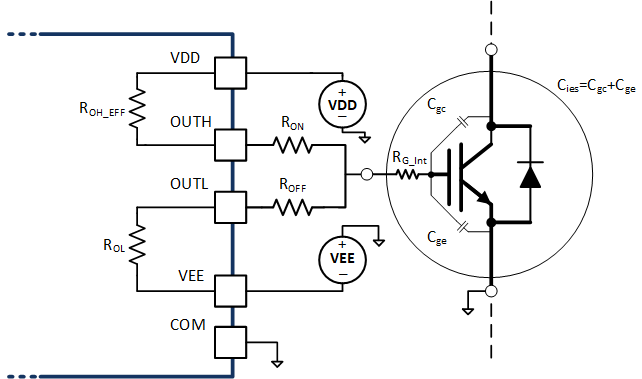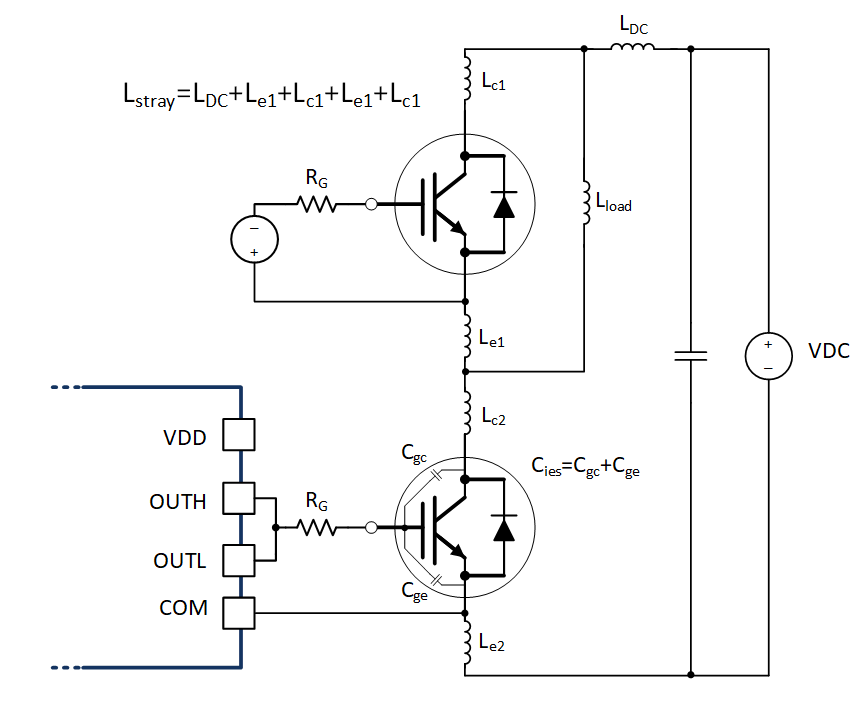SLUSEK4B April 2022 – June 2024 UCC21717-Q1
PRODUCTION DATA
- 1
- 1 Features
- 2 Applications
- 3 Description
- 4 Pin Configuration and Functions
-
5 Specifications
- 5.1 Absolute Maximum Ratings
- 5.2 ESD Ratings
- 5.3 Recommended Operating Conditions
- 5.4 Thermal Information
- 5.5 Power Ratings
- 5.6 Insulation Specifications
- 5.7 Safety Limiting Values
- 5.8 Electrical Characteristics
- 5.9 Switching Characteristics
- 5.10 Insulation Characteristics Curves
- 5.11 Typical Characteristics
- 6 Parameter Measurement Information
-
7 Detailed Description
- 7.1 Overview
- 7.2 Functional Block Diagram
- 7.3
Feature Description
- 7.3.1 Power Supply
- 7.3.2 Driver Stage
- 7.3.3 VCC and VDD Undervoltage Lockout (UVLO)
- 7.3.4 Active Pulldown
- 7.3.5 Short Circuit Clamping
- 7.3.6 Internal Active Miller Clamp
- 7.3.7 Overcurrent and Short Circuit Protection
- 7.3.8 Soft Turn-Off
- 7.3.9 Fault (FLT), Reset and Enable (RST/EN)
- 7.3.10 Isolated Analog to PWM Signal Function
- 7.4 Device Functional Modes
-
8 Applications and Implementation
- 8.1 Application Information
- 8.2
Typical Application
- 8.2.1 Design Requirements
- 8.2.2
Detailed Design Procedure
- 8.2.2.1 Input Filters for IN+, IN-, and RST/EN
- 8.2.2.2 PWM Interlock of IN+ and IN-
- 8.2.2.3 FLT, RDY, and RST/EN Pin Circuitry
- 8.2.2.4 RST/EN Pin Control
- 8.2.2.5 Turn-On and Turn-Off Gate Resistors
- 8.2.2.6 Overcurrent and Short Circuit Protection
- 8.2.2.7 Isolated Analog Signal Sensing
- 8.2.2.8 Higher Output Current Using an External Current Buffer
- 9 Power Supply Recommendations
- 10Layout
- 11Device and Documentation Support
- 12Revision History
- 13Mechanical, Packaging, and Orderable Information
Package Options
Mechanical Data (Package|Pins)
- DW|16
Thermal pad, mechanical data (Package|Pins)
- DW|16
Orderable Information
8.2.2.5 Turn-On and Turn-Off Gate Resistors
The UCC21717-Q1 features split outputs OUTH and OUTL, which enables independent control of the turn on and turn off switching speeds. The turn on and turn off resistances determine the peak source and sink currents, which control the switching speed in turn. Meanwhile, power dissipation in the gate driver should be considered to ensure the device is in the thermal limit. At first, the peak source and sink currents are calculated as:

Where
- ROH_EFF is the effective internal pull-up resistance of the hybrid pull-up structure, which is approximately 2 x ROL, about 0.7 Ω.
- ROL is the internal pulldown resistance, about 0.3 Ω.
- RON is the external turn on gate resistance.
- ROFF is the external turn off gate resistance.
- RG_Int is the internal resistance of the SiC MOSFET or IGBT module.
 Figure 8-5 Output Model for Calculating
Peak Gate Current
Figure 8-5 Output Model for Calculating
Peak Gate CurrentFor example, for an IGBT module based system with the following parameters:
- Qg = 3300 nC
- RG_Int = 1.7 Ω
- RON=ROFF= 1 Ω
The peak source and sink currents in this case are:

Thus by using a 1-Ω external gate resistance, the peak source current is 5.9 A and the peak sink current is 6.7 A. The collector-to-emitter dV/dt during the turn on switching transient is dominated by the gate current at the Miller plateau voltage. The hybrid pullup structure ensures the peak source current at the Miller plateau voltage, unless the turn on gate resistor is too high. The faster the collector-to-emitter, Vce, voltage rises to VDC, the smaller the turn on switching loss is. The dV/dt can be estimated as Qgc/Isource_pk. For the turn off switching transient, the drain-to-source dV/dt is dominated by the load current, unless the turn off gate resistor is too high. After Vce reaches the dc bus voltage, the power semiconductor is in saturation mode and the channel current is controlled by Vge. The peak sink current determines the dI/dt, which dominates the Vce voltage overshoot accordingly. If using relatively large turn off gate resistance, the Vce overshoot can be limited. The overshoot can be estimated by:

Where
- Lstray is the stray inductance in power switching loop, as shown in Figure 8-6
- Iload is the load current, which is the turn off current of the power semiconductor.
- Cies is the input capacitance of the power semiconductor.
- Vplat is the plateau voltage of the power semiconductor.
- Vth is the threshold voltage of the power semiconductor.
 Figure 8-6 Stray Parasitic Inductance of
IGBTs in a Half-Bridge Configuration
Figure 8-6 Stray Parasitic Inductance of
IGBTs in a Half-Bridge ConfigurationPower dissipation should be taken into account to maintain the gate driver within the thermal limit. The power loss of the gate driver includes the quiescent loss and the switching loss, which can be calculated as:

PQ is the quiescent power loss for the driver, which is Iq x (VDD-VEE) = 5 mA x 20 V = 0.100 W. The quiescent power loss is the power consumed by the internal circuits such as the input stage, reference voltage, logic circuits, protection circuits when the driver is switching when the driver is biased with VDD and VEE, and also the charging and discharging current of the internal circuit when the driver is switching. The power dissipation when the driver is switching can be calculated as:

Where
- Qg is the gate charge required at the operation point to fully charge the gate voltage from VEE to VDD.
- fsw is the switching frequency.
In this example, the PSW can be calculated as:

Thus, the total power loss is:

When the board temperature is 125°C, the junction temperature can be estimated as:

Therefore, for the application in this example, with 125°C board temperature, the maximum switching frequency is ~50 kHz to keep the gate driver in the thermal limit. By using a lower switching frequency, or increasing external gate resistance, the gate driver can be operated at a higher switching frequency.